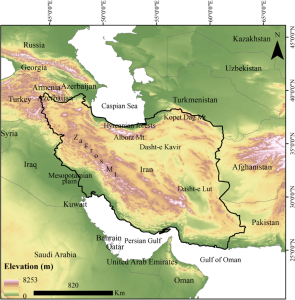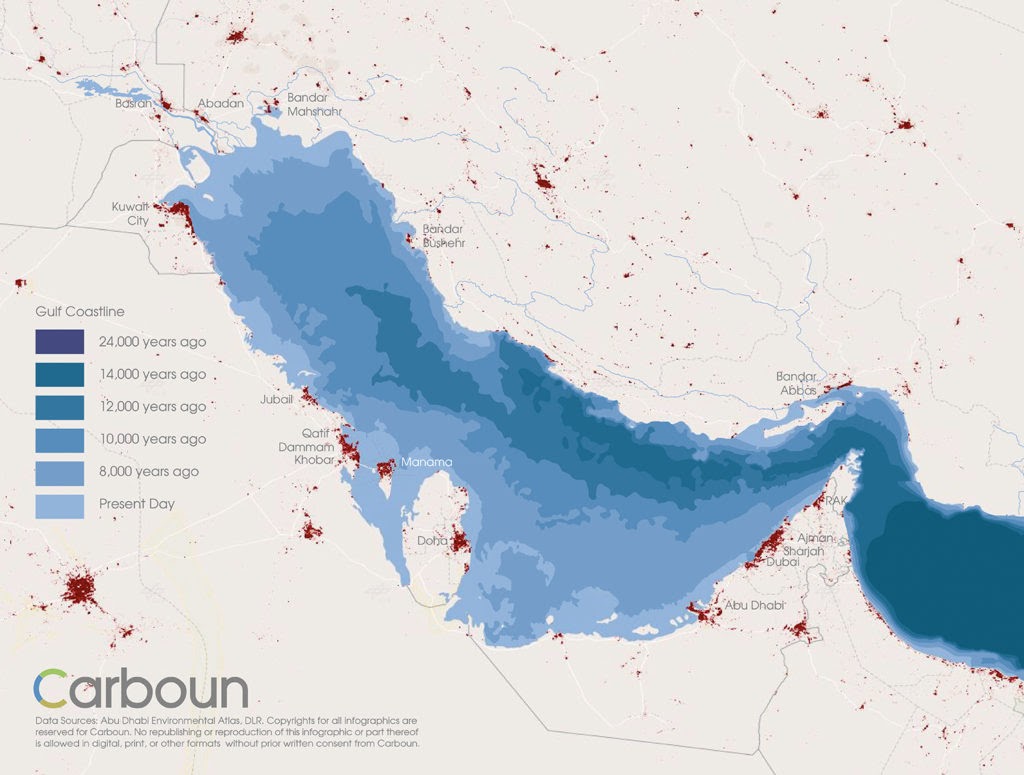
Climate change is reshaping the Persian Gulf’s environment, economy, and maritime sector. Learn how rising heat, salinity, storms, and sea levels affect the region.
The Persian Gulf—one of the world’s most strategic maritime regions—is warming faster than most other oceans on Earth. This semi-enclosed basin, bordered by Iran, Iraq, Kuwait, Saudi Arabia, Qatar, Bahrain, Oman, and the UAE, is highly sensitive to even slight climatic disruptions due to its shallow depth, extreme summer temperatures, limited water exchange with the open ocean, and dense coastal populations.
Climate change is no longer a distant risk in the Gulf; it is a daily reality shaping ecosystems, shipping, energy infrastructure, fisheries, desalination operations, and regional security. From unprecedented marine heatwaves to coastal flooding threats around vital ports, the Gulf is experiencing transformations that carry both environmental and socio-economic consequences.
Why This Topic Matters in Modern Maritime Operations
Few regions combine environmental fragility with geopolitical importance like the Persian Gulf. It hosts:
- ~30% of the world’s crude oil shipments
- Major ports such as Jebel Ali, Dammam, Ras Laffan, Bandar Abbas, and Umm Qasr
- Critical maritime chokepoints, including the Strait of Hormuz
- Large offshore energy infrastructure
- Rapidly expanding coastal megacities, many built at or near sea level
According to the IMO, climate change is a “risk multiplier” for maritime safety and port resilience. The IPCC’s Sixth Assessment Report (AR6) notes that the Gulf’s surface ocean temperatures have risen ~0.6–1.0°C since the 1980s, significantly above the global average. Meanwhile, UNESCWA reports record-breaking marine heatwaves in 2017, 2019, 2021, and 2023, many of which caused massive coral bleaching and fish mortality.
With so much maritime traffic, infrastructure, and population concentrated in vulnerable zones, climate impacts in the Gulf are not local—they affect global shipping, energy security, and supply chains.

Key Climate Change Developments Affecting the Persian Gulf
Rising Sea Surface Temperatures: A Rapidly Warming Basin
Over the past four decades, the Persian Gulf has warmed at nearly twice the global ocean rate. With average summer sea surface temperatures (SSTs) now reaching 34–36°C, the region is witnessing conditions close to physiological limits for many marine organisms.
Why does the Gulf warm so quickly?
The Gulf’s geography plays a major role:
- Shallow depth: Average 35–40 m, compared to thousands of meters in major oceans
- High air temperatures exceeding 50°C during heatwaves
- Limited water exchange through the Strait of Hormuz
- High salinity, reduces the capacity of water to absorb additional heat
The result is a basin with low resilience to temperature fluctuations.
Ecological consequences
Marine heatwaves, as defined by NOAA and IOC-UNESCO, are prolonged periods when water temperatures exceed the seasonal average by a significant margin. In the Gulf, these heatwaves have led to:
- Mass coral bleaching, especially in the UAE, Bahrain, and Qatar
- Declines in sensitive fish species
- Collapse of local seagrass meadows, which are essential for dugongs and juvenile fish
- Increased harmful algal blooms (HABs)
Some coral species in the Gulf are temperature-tolerant, but even these are nearing their upper limit of 36–38°C.
–
Extreme Weather, Dust Storms, and Changing Wind Patterns
Climate change is not just warming waters—it is altering atmospheric conditions. A hotter, drier climate strengthens the Shamal winds, increases desertification, and intensifies dust storms.
Impacts on maritime operations
- Reduced visibility for vessels entering and leaving ports
- More frequent port closures during severe dust events
- Increased wear on engines, filters, and deck equipment
- Higher accident risk in congested waterways
The World Bank notes that dust storm frequency in Iraq, Kuwait, and Saudi Arabia could triple by 2050, directly affecting ports like Umm Qasr and Jubail.
–
Sea Level Rise and Coastal Flooding Risks
Although global sea levels are rising at ~3–4 mm/year, the Persian Gulf’s subsidence and coastal development mean that local relative sea level rise (RSLR) can be significantly higher.
Cities and ports at risk
Many Persian Gulf cities were built on reclaimed land or low-lying coastal zones:
- Dubai
- Doha
- Abu Dhabi
- Bahrain (Manama)
- Kuwait City
- Dammam
- Bandar Abbas
UNESCO coastal risk assessments show that a 0.5 m rise could:
- Flood port terminals
- Damage quay walls
- Increase corrosion of maritime infrastructure
- Disrupt desalination plants
- Affect storage tanks and pipelines
- Push saltwater intrusions into groundwater
Several Gulf countries have begun constructing breakwaters, artificial islands, and surge barriers, similar to resilience measures recommended by IAPH and EMSA.

A bathymetry map of the Persian Gulf. Note the shallow water depths for the Persian Gulf.
Salinity Increases: Why the Persian Gulf Is Becoming Saltier
The Gulf is one of the most saline seas on the planet, averaging 40–43 PSU, compared to the global ocean’s ~35 PSU. Climate change is pushing salinity even higher due to:
- Reduced rainfall
- Increased evaporation
- Higher temperatures
- Discharge of highly saline brine from desalination plants
- Limited water circulation
High salinity stresses marine organisms, reduces oxygen solubility, and alters fish migration patterns. The Gulf’s unique marine biodiversity—including its heat-tolerant corals—now faces a dual challenge of warming and hyper-salinity.
–
Stronger Marine Heatwaves and Algal Blooms
Harmful algal blooms (HABs), sometimes called “red tides,” have become more frequent in the Gulf since the early 2000s. Climatic factors contribute to their expansion:
- Warmer, nutrient-rich waters
- Changes in circulation
- Increased coastal development
- Ballast water discharges
HABs often force port shutdowns and disrupt desalination plants. In 2008–2009, a major red tide severely affected UAE and Omani desalination operations, causing water shortages and economic losses.
The trend continues today, with HAB monitoring now integrated into several national early-warning systems.
–
Impact on Regional Fisheries and Marine Biodiversity
Fisheries in the Persian Gulf contribute to food security and cultural identity, yet climate change has pushed many species toward decline.
Observed changes include:
- Reduced populations of shrimp, hamour (grouper), and pomfret
- Shifts in seasonal migration
- Increased fish mortality during heatwaves
- Coral reef degradation reducing nursery habitats
- Competition with invasive species tolerant of extreme conditions
The FAO and Gulf Marine Pollution Monitoring reports show that some commercially important species have declined by 30–70% over the last decade.
–
Desalination Plants Under Stress
Water scarcity makes the Gulf region heavily dependent on desalination. Yet the same climate change pressures acting on the Gulf’s marine environment also challenge desalination operations.
Main issues
- Warmer seawater reduces efficiency of desalination membranes and thermal plants.
- More algae and turbidity increase filtration and energy costs.
- Higher salinity further increases operating pressure and energy consumption.
- Storm surges and coastal flooding can disrupt intakes.
With the Gulf producing ~40% of the world’s desalinated water, any climate impact here becomes a global concern.
–
Challenges and Practical Solutions
Challenge 1: Rising Water Temperatures and Ecological Collapse
Solutions
- Expansion of marine protected areas (MPAs)
- Coral restoration projects, including UAE and Saudi Arabia initiatives
- Temperature-resistant coral breeding programs (NOAA, KAUST)
- Aligning coastal development with ICZM principles
Challenge 2: Sea Level Rise and Coastal Infrastructure Vulnerability
Solutions
- Elevating critical port infrastructure
- Building surge-protection walls
- Updating port masterplans using climate-risk scenario models
- Integrating IMO and IAPH climate-resilience guidance into planning
Challenge 3: Growing Storms and Dust Events Affecting Maritime Logistics
Solutions
- Advanced weather routing systems
- Dust-resistant port equipment
- Vessel traffic management systems (VTMS)
- Emergency response plans based on EMSA and USCG best practices
Challenge 4: Salinity and HABs Affecting Water and Energy Security
Solutions
- Diversifying water resources
- Early-warning ocean monitoring platforms
- Upgrading desalination plants with algae-resistant membranes
–
Case Studies / Real-World Applications
Coral Bleaching in Bahrain and UAE (2017–2023)
Bahrain and the UAE documented severe reef losses after intense marine heatwaves. Surveys by the Environment Agency–Abu Dhabi (EAD) and KAUST found >70% bleaching in some areas, prompting large-scale restoration efforts.
Doha, Dubai, and Manama Sea-Level Risk Modelling
The World Bank and UNDRR have modelled how a 0.5–1.0 m sea-level rise could affect coastal megacities and ports. These models now influence flood-defence design.
Port of Jebel Ali – Climate Resilience Upgrades
DP World has implemented shoreline reinforcement, elevation planning, and early-warning systems for extreme weather—now considered best practice in Gulf logistics.
Saudi Arabia’s Red Sea and Gulf Coral Restoration Projects
Over 100 million coral fragments are being restored through mega-projects that also inform science on heat-tolerant coral strains.
–
Future Outlook & Trends
1. More Frequent and Severe Marine Heatwaves
The Gulf is projected to experience annual heatwaves by 2050, pushing marine life to critical limits.
2. Accelerated Sea-Level Rise
Low-lying coasts remain at risk. Ports will require continuous adaptation.
3. Stronger Policy Coordination
Regional organisations will increasingly work with IMO, UNEP, and IHO on climate-resilient maritime governance.
4. Expansion of Desalination Technology
Energy-efficient systems (e.g., forward osmosis, hybrid RO) will reduce stress on marine ecosystems.
5. Coastal Megacity Planning
Urban planners will integrate flood modelling and nature-based solutions, including mangrove restoration.
6. Maritime Transport Adaptation
Vessels operating in the Gulf will require improved cooling systems, dust-resistant components, and alternative fuels that reduce regional emissions.
–
FAQ
1. Why is the Persian Gulf warming faster than other seas?
Because it is shallow, extremely hot, and has limited water exchange. These factors make it highly sensitive to temperature increases.
2. How does climate change affect shipping in the Gulf?
Dust storms, extreme heat, HABs, and sea-level rise affect visibility, engine performance, port operations, and safety.
3. Are coral reefs in the Persian Gulf dying?
Many reefs are severely stressed or dying due to heatwaves, but some heat-tolerant species persist, and restoration programs are underway.
4. What is the biggest climate threat to Gulf cities?
Sea-level rise and coastal flooding, particularly for low-lying megacities.
5. Does desalination contribute to climate stress?
Yes. It increases salinity and requires energy, but modern plants are becoming more efficient.
6. How will fisheries be affected in the future?
Many species may decline due to warming, salinity, and habitat loss. Without adaptation, food security could be threatened.
7. Is regional cooperation improving?
Yes. Countries are increasingly working through regional marine organisations, IMO committees, and climate-resilience initiatives.
–
Conclusion
Climate change is transforming the Persian Gulf faster than almost any other marine region. Rising sea temperatures, stronger storms, unprecedented heatwaves, and sea-level rise threaten ecosystems, coastal cities, fisheries, and maritime infrastructure. Yet the Gulf’s nations, researchers, and port authorities are responding with science-based strategies—restoration programs, nature-based solutions, climate-resilient port design, and new desalination technologies.
For maritime professionals, understanding these regional dynamics is essential. The Gulf is not just a geographic area—it is a global maritime artery whose climate impacts echo across markets and supply chains. A climate-resilient Persian Gulf is therefore a climate-resilient world economy.
–
References
International Bodies
-
Intergovernmental Panel on Climate Change (IPCC). (2021). AR6 Climate Change 2021. https://www.ipcc.ch
-
International Maritime Organization (IMO). https://www.imo.org
-
United Nations Conference on Trade and Development (UNCTAD). https://unctad.org
-
World Bank – Climate and Disaster Risk. https://www.worldbank.org/en/topic/climatechange
Ocean & Climate Research
-
NOAA – Marine Heatwaves & SST data. https://www.noaa.gov
-
NASA Climate Change. https://climate.nasa.gov
-
ESA Climate Office. https://climate.esa.int
-
IOC-UNESCO – Ocean Observations. https://ioc.unesco.org
Regional & Gulf Studies
-
KAUST Marine Science Publications. https://www.kaust.edu.sa/en/research
-
UNEP West Asia. https://www.unep.org/westasia
-
ESCWA Climate Reports. https://www.unescwa.org
Maritime Authorities & Safety Agencies
-
US Coast Guard. https://www.uscg.mil
-
UK Maritime & Coastguard Agency (MCA). https://www.gov.uk/government/organisations/maritime-and-coastguard-agency
Classification Societies
-
DNV Maritime. https://www.dnv.com/maritime
-
Lloyd’s Register. https://www.lr.org
-
RINA. https://www.rina.org
Port Operators
-
DP World Sustainability. https://www.dpworld.com/sustainability
Academic Journals & Marine Institutes
-
Marine Pollution Bulletin. https://www.sciencedirect.com/journal/marine-pollution-bulletin
-
Journal of Marine Systems. https://www.sciencedirect.com/journal/journal-of-marine-systems
-
Scripps Institution of Oceanography. https://scripps.ucsd.edu

